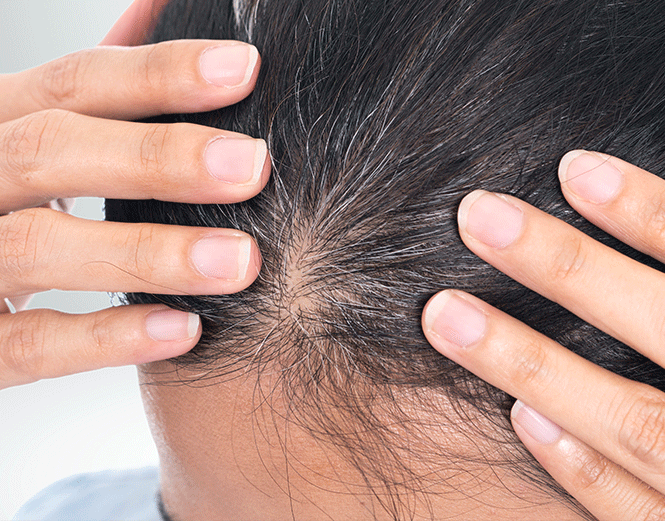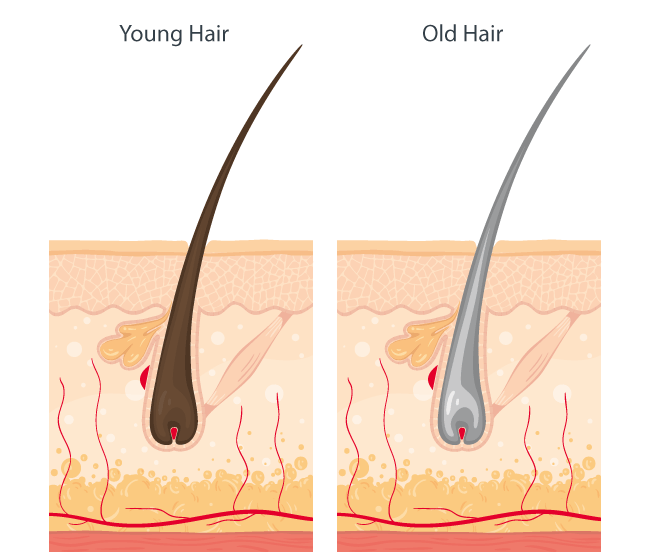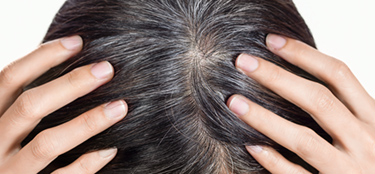Aging / Thinning Hair
Humans have always looked for ways to slow down the body’s natural aging process and reduce external signs of getting older. However, with the rise in life expectancy people are feeling more youthful in later years and want their appearance to reflect this. As such, the desire to look younger plays a more significant role and products and treatments to help do so are more widespread than ever before.
Just like our skin, our hair is subject to natural aging as we grow older. We most commonly think of a change in colour, but mature hair also changes in its texture. Furthermore, thinning hair is more frequent in the elderly and can affect both sexes. As such aging hair requires a tailored hair care routine to reduce these symptoms.

The common belief that the rate of aging can be measured by the number of grey hairs on our heads is partly but not entirely correct. Grey hairs can also appear at a much younger age, for example, due to a genetic predisposition. The hair’s natural aging process begins between the age of 25 and 40. As we age, our hair undergoes noticeable changes in density, texture, and manageability. Dryness and a feeling of tension in the scalp are also symptoms commonly experienced in mature hair. If the hair is not provided with the nutrients necessary for healthy growth, the hair can lose suppleness and shine, making styling difficult.
Age-related hormonal changes also cause the hair’s anagen or growth phase to become shorter and the telogen or resting phase to become longer. This results in the production of less and thinner hair. These changes can have a significant effect on our overall well-being and self-confidence, as our hair’s appearance is often perceived as an expression of our self-image. Furthermore, the hair’s natural resilience decreases as we age, it becomes more sensitive to external factors, and requires extra care.
How does our hair change as we age?
Grey hair or “going grey” is one of the first signs of aging hair. The hair on the scalp often begins greying at the temples, and this pattern then extends to the top of the scalp. The follicles that generate our hair contain melanocytes, cells responsible for the production of melanin. As we get older, these cells slow down their melanin production. Our genes largely determine the age at which this happens. While some may notice their first grey hairs in their 20s, most will find some grey hairs on their head in their 30s, and by their 50s many will have a significant amount of grey hair.
Thinning hair is also a frequent problem in mature hair. Firstly, the density of the hair decreases, and the hairs grow much finer, sometimes becoming barely visible. This can be followed by hair loss. As we grow older, the average hair loss rate of 100 hairs a day increases as hair follicles cannot replace the lost hairs as quickly as in younger years. This results in a thinning of the hair on the crown of the head, making the scalp more visible. A regular hair care routine can stimulate blood circulation and strengthen the hair roots, prolonging the active growth phase and increasing density.

As the hairs become thinner, the hair also loses volume and elasticity, making it more brittle. This is particularly true for hair that has repeatedly been treated with chemicals or heat, which make it prone to breaking.
Mature hair is also often drier than younger hair. The sebaceous glands in the hair follicles shrink and produce less oil. As such, the hair loses its natural moisturizing, protective layer. This also makes it less manageable and difficult to style. A well-maintained hair care routine can restore moisture.
As we age, our hair tends to lose its natural shine and lustre, making it seem dull and lifeless. This is on the one hand owing to the reduction in natural moisture, and on the other, to the changes in the surface of the hair shaft. Mature, grey hair has a rougher, coarser texture, in part due to the reduction of melanin. Changes in the hair’s texture can also be triggered by age-related hormonal fluctuations, as they may occur during the menopause, for example.


